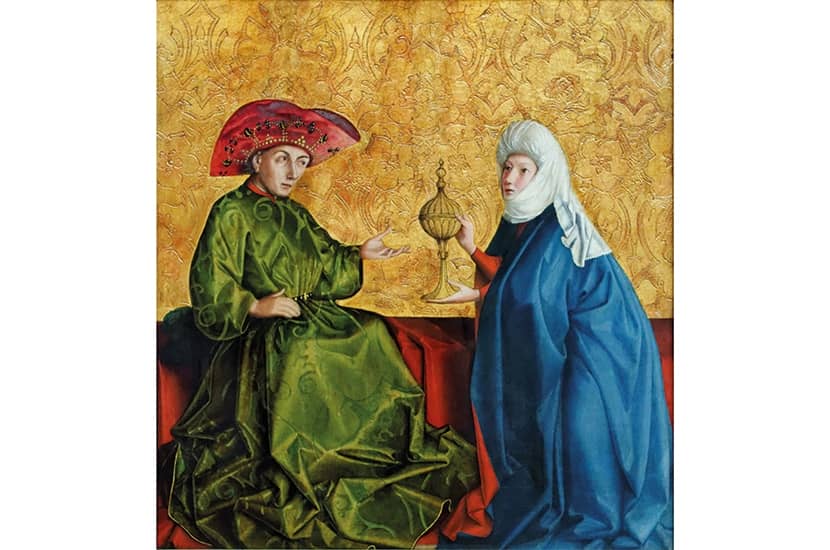The Italian writer Roberto Calasso, who died in July at the age of eighty, was an anomalous and fascinating figure on the international literary scene. In his early twenties he began working for the prestigious publishers Adelfi Edizioni and stayed with them his whole life, eventually becoming editorial director and, when the firm was threatened with a takeover, purchasing it. In his thirties he began writing a series of idiosyncratic books. The second of these, The Marriage of Cadmus and Harmony, established his reputation and was translated into many languages.
Something should be said about it because the project it enacts is related to this last of his books. The Marriage of Cadmus and Harmony is a retelling of the principal Greek myths, incorporating variant versions, performed with such imaginative flair that it takes the reader deep into the mindset of Greek myth. The Book of All Books — the title is taken from Goethe — is a retelling of the Hebrew Bible. It exhibits much of the vividness and wide-ranging erudition of the earlier book, but the results are more uneven.
Calasso’s retelling is intentionally an intellectual potpourri, and that is the source both of its appeal and its weakness. He begins with a midrash, the characteristic early rabbinic mode of exegesis that amplifies, elaborates and sometimes reinvents the spare biblical text. Other midrashim are then introduced from time to time as well as midrashim that one assumes are Calasso’s own invention. For some stretches of the book, he simply retells the canonical narrative, and these sections are not likely to be of much interest to anyone already familiar with the Bible. More welcome are the frequent junctures in which he midrashically fleshes out what is tersely told in the Bible. Here he is on the inception of the Queen of Sheba’s visit to Solomon:
“The Queen of Sheba stepped out early in the morning to salute the Sun. The sky darkened. A flock of hoopoes was circling around. One glided beside her. It had a letter tied to its wing. The queen opened it and started reading. It came from someone she had never heard of, a king called Solomon. And it was an invitation to visit him.”
More compactly, when the victorious David brings to Saul the large number of Philistine foreskins the king had demanded of him as a bride-price for his daughter, we are told: ‘The scraps of mangled flesh were laid on a tray.’ Or again, a glimpse of Jerusalem when Solomon’s temple and palace were under construction:
“Jerusalem was looking more and more like a warehouse: big, squared stones, stacks of beams from Lebanon, heaps of metal brackets, and, so they said, silver and gold were ‘common as stones’ in the city.”
Why not invite us to see the fearfully diffident Saul by way of Harpo Marx?
Elsewhere, the group of young women Saul meets before first encountering Samuel are, in Tim Parks’s lively translation, “a gaggle of girls.”
This retelling of the Bible is also enlivened by its range of intertextual references — Racine, Kafka, Freud, Nietzsche — to whom Calasso adds the Veda, the Indian text he cherished. In a few instances, a surprising comparison is combined with a genuine insight into the biblical story:
“Saul hid among the bags — something Harpo Marx would do — paralyzed by the terror of election that more than any other would afflict his people in the future, the terror of the drawn lot, the chance that a moment later might select him.”
Such perceptions show Calasso to be an alert interpreter of the narrative. About Saul’s successor, for example, he observes that ‘David was racked by doubts. He seemed condemned to love people who wanted him dead’.
Yet for all these winning moments, there is much that is flawed in this book. Calasso gets certain details wrong. The destruction of the Second Temple in 70 AD comes six centuries after Isaiah, not nine. The Song of Songs and Ecclesiastes are not the only two books in the Bible that don’t mention the name of Yahweh — it never appears in Esther. Ruth is definitely not a “slave,” and she does not get pregnant by Boaz when she lies beside him on the threshing-floor, as that would make the subsequent legal negotiation about which kinsman of Naomi is to marry her meaningless.
Perhaps what is most curious is that though Calasso is chiefly interested in Jewish readings of Scripture — the Midrash, the Zohar, Maimonides and not Aquinas — there are intermittent passages that invoke discredited supersessionist notions of the Old Testament as an anticipation or prefiguration of the New. “So the idea of the Messiah begins to take shape in David’s mind… something dazzling and vast, whose end one could not see.” But the word “messiah’ in the David story has a strictly political sense, designating the legitimately anointed monarch, and carries no intimation of eschatological consummations. The Christ figure is not “foreshadowed” in the Suffering Servant of Second Isaiah, despite centuries of Christian interpretation that he is.
Calasso is preoccupied with the idea of animal sacrifice: it becomes virtually the major theme of the Hebrew Bible in his retelling, and I suspect this has a lot to do with his having the crucifixion in mind: “For redemption [in the Hebrew Bible] to work, blood was required. Even if that meant the blood of a single divine being.” There are many reflections here on the meaning of sacrifice, and often they are rather opaque. The sundry Near Eastern gods, he writes, “required sacrifices, because only sacrifice allows the divine to circulate” — what could that possibly mean? — “but none of them were as uncompromising as Yahweh in claiming the totality of life for themselves, and in forbidding men to dispose of it freely.”
Calasso was a person of very broad learning. Besides the major western European languages, he had a mastery of Greek and Latin, learned Sanskrit, and appeared to have acquired at least some biblical Hebrew. He sometimes gets a Hebrew term with its nuances exactly right, but he also makes quite a few mistakes. He draws on a multiplicity of translations in different languages, but the one he chiefly favors is the Latin version, the Vulgate, and that can lead him astray. The still, small voice of the divine heard by Elijah, aptly rendered with those words in the King James version, becomes, in the wake of the Vulgate, the more fanciful “sound of a light breeze.”
More misleadingly, again following the Vulgate, Abigail, who will become David’s wife, is said to be “shrewd and extremely cautious,” whereas what the Hebrew actually says is that she “has a good mind,” tovat sekhel, and “lovely looks,” yefat to’ar. The mistake makes a difference in what we see happening in the story. Abigail’s beauty, disappearing in “shrewd,” plays a role in the attraction she exerts for David, and far from being “extremely cautious,” she is quite bold in the initiative she takes to head off David’s men bent on vengeance against her disagreeable husband and who conceivably might have killed her.
Calasso’s great virtue as a writer is his willingness to go with the impulses of his own interests and preoccupations, even when they might seem rather remote from the subject at hand. Sometimes when he does this here, the effect can be annoying. It is hard to see, for example, why a lengthy, and in some respects obscure, chapter on Freud’s Moses and monotheism advances his project of retelling the Bible. But this is the defect of what I think can justly be called a virtue. Calasso throughout his career had a passionate interest in myth, and his version of the biblical story is enhanced by its frequent forays into ancient Near Eastern mythology as well as into its Indian analogues.
He is also drawn to the bizarre, which explains why he devotes a chapter not to Isaiah or Jeremiah but to Ezekiel, surely the weirdest of all the biblical prophets. And his modern references definitely impart an allure to his narrative. Why not pick up a diary entry by Kafka as a clue to something going on in the Bible, or why not invite us to see the fearfully diffident Saul by way of Harpo Marx?
The Book of All Books, in sum, is a very mixed and eccentric production but hardly an authoritative account of the Hebrew Bible. In some ways it is misleading, in others exasperating, but it is also beguiling, and there are points at which it actually throws fresh light on the biblical story.
This article was originally published in The Spectator’s UK magazine. Subscribe to the World edition here.


















